Study on the Depositional Microfacies and Internal Architecture of Sandy Debris Flows in Low-Permeability Oilfields: Implications for Remaining Oil Recovery in the HeShui Oilfield
Abstract
:1. Introduction
2. Field Background and Geological Setting
3. Materials and Methods
3.1. Methodological Framework
3.2. Stratigraphy Divisions
3.3. Sedimentary Analysis
3.4. Internal Configuration of Sand Bodies
3.5. Remaining Oil Investigation
4. Results and Discussion
4.1. Fine Stratigraphic Framework Construction
4.2. Regional Geological Sedimentary Model
4.3. Internal Characteristics of Sandy Debris Flows
4.4. Internal Sand Body Configuration-Based Remaining Oil Distribution
5. Conclusions
Author Contributions
Funding
Data Availability Statement
Acknowledgments
Conflicts of Interest
References
- Wang, Z.; Li, S.; Li, M.; Husein, M.M. Enhanced Oil Recovery and Carbon Sequestration in Low-Permeability Reservoirs: Comparative Analysis of CO2 and Oil-Based CO2 Foam. Fuel 2025, 381, 133319. [Google Scholar] [CrossRef]
- Lai, J.; Wang, G.; Wang, Z.; Chen, J.; Pang, X.; Wang, S.; Zhou, Z.; He, Z.; Qin, Z.; Fan, X. A Review on Pore Structure Characterization in Tight Sandstones. Earth-Sci. Rev. 2018, 177, 436–457. [Google Scholar] [CrossRef]
- Feng, J.; Shang, L.; Li, X.; Luo, P. 3D Numerical Simulation of Heterogeneous in Situ Stress Field in Low-Permeability Reservoirs. Pet. Sci. 2019, 16, 939–955. [Google Scholar] [CrossRef]
- Fan, T.; Song, X.; Wu, S.; Li, Q.; Wang, B.; Li, X.; Li, H.; Liu, H. A Mathematical Model and Numerical Simulation of Waterflood Induced Dynamic Fractures of Low Permeability Reservoirs. Pet. Explor. Dev. 2015, 42, 541–547. [Google Scholar] [CrossRef]
- Kang, W.-L.; Zhou, B.-B.; Issakhov, M.; Gabdullin, M. Advances in Enhanced Oil Recovery Technologies for Low Permeability Reservoirs. Pet. Sci. 2022, 19, 1622–1640. [Google Scholar] [CrossRef]
- Yuan, S.; Han, H.; Wang, H.; Luo, J.; Wang, Q.; Lei, Z.; Xi, C.; Li, J. Research Progress and Potential of New Enhanced Oil Recovery Methods in Oilfield Development. Pet. Explor. Dev. 2024, 51, 963–980. [Google Scholar] [CrossRef]
- Chenghua, O.; Xiaolu, W.; Chaochun, L.; Yan, H. Three-Dimensional Modelling of a Multi-Layer Sandstone Reservoir: The Sebei Gas Field, China. Acta Geol. Sin. 2016, 90, 209–221. [Google Scholar] [CrossRef]
- Qiao, J.; Zeng, J.; Jiang, S.; Feng, S.; Feng, X.; Guo, Z.; Teng, J. Heterogeneity of Reservoir Quality and Gas Accumulation in Tight Sandstone Reservoirs Revealed by Pore Structure Characterization and Physical Simulation. Fuel 2019, 253, 1300–1316. [Google Scholar] [CrossRef]
- Hui, G.; Chen, Z.; Wang, Y.; Zhang, D.; Gu, F. An Integrated Machine Learning-Based Approach to Identifying Controlling Factors of Unconventional Shale Productivity. Energy 2023, 266, 126512. [Google Scholar] [CrossRef]
- Gao, Z.; Shi, J.; Xie, Q.; Zhou, Y.; Zhou, S. Classification and Evaluation of Tight Sandstone Reservoirs Based on Diagenetic Facies: A Case Study on Chang 6 Reservoir in the Center-West Ordos Basin. J. Pet. Explor. Prod. Technol. 2022, 12, 1203–1216. [Google Scholar]
- Hui, G.; Chen, S.; Wang, Y.; Gu, F. The Effect of Hydraulic-Natural Fracture Networks on the Waterflooding Development in a Multilayer Tight Reservoir: Case Study. Geofluids 2021, 2021, 1–15. [Google Scholar]
- Hou, Y.T.; Wang, T.; Hu, X.F.; Yan, R.H.; Wang, D.L. Control and Import of Sedimentary Microfacies on Tight Oil Occurrence in the Chang 7-3 Member of the Triassic Yanchang Formation, Ordos Basin of China. In Proceedings of the SPE/AAPG/SEG Unconventional Resources Technology Conference, San Antonio, TX, USA, 1–3 August 2016. [Google Scholar] [CrossRef]
- Zhang, Z.; Tang, J.; Zhang, J.; Meng, S.; Li, J. Modeling of Scale-Dependent Perforation Geometrical Fracture Growth in Naturally Layered Media. Eng. Geol. 2024, 336, 107499. [Google Scholar]
- Li, A.; Yang, X.; Fan, C.; Ye, Q.; Wang, Z.; Li, M. Sandy Debris Flow Sedimentary Characteristics and Patterns in the Meishan Formation of Northern Lingshui Sag, Qiongdongnan Basin. J. Phys. Conf. Ser. 2020, 1549, 022009. [Google Scholar]
- Cao, Y.; Jin, J.; Liu, H.; Yang, T.; Liu, K.; Wang, Y.; Wang, J.; Liang, C. Deep-Water Gravity Flow Deposits in a Lacustrine Rift Basin and Their Oil and Gas Geological Significance in Eastern China. Pet. Explor. Dev. 2021, 48, 286–298. [Google Scholar]
- Sun, N.; Zhong, J.; Hao, B.; Ge, Y.; Swennen, R. Sedimentological and Diagenetic Control on the Reservoir Quality of Deep-Lacustrine Sedimentary Gravity Flow Sand Reservoirs of the Upper Triassic Yanchang Formation in Southern Ordos Basin, China. Mar. Pet. Geol. 2020, 112, 104050. [Google Scholar]
- Jon, R.; Basin, D.; Marco, F.; Thieblemont, A. Beds created by (mostly) sediment gravity flows. In Proceedings of the SEG/AAPG International Meeting for Applied Geoscience & Energy, Houston, TX, USA, 28 August–1 September 2022. [Google Scholar] [CrossRef]
- Palermo, D.; Galbiati, M.; Famiglietti, M.; Marchesini, M.; Mezzapesa, D.; Fonnesu, F. Insights into a New Super-Giant Gas Field—Sedimentology and Reservoir Modeling of the Coral Reservoir Complex, Offshore Northern Mozambique. In Proceedings of the Offshore Technology Conference-Asia, Kuala Lumpur, Malaysia, 25–28 March 2014. [Google Scholar] [CrossRef]
- Di, C.; Wei, Y.; Wang, K.; Deng, P.; Chen, B.; Shen, L.; Chen, Z. The Impact of Pressurization-Induced Decrease of Capillary Pressure and Residual Saturation on Geological Carbon Dioxide Storage. J. Clean. Prod. 2025, 486, 144573. [Google Scholar]
- Hui, G.; Chen, S.; He, Y.; Wang, H.; Gu, F. Machine Learning-Based Production Forecast for Shale Gas in Unconventional Reservoirs via Integration of Geological and Operational Factors. J. Nat. Gas Sci. Eng. 2021, 94, 104045. [Google Scholar]
- Tang, J.; Zhang, Z.; Xie, J.; Meng, S.; Xu, J.; Ehlig-Economides, C.; Liu, H. Re-Evaluation of CO2 Storage Capacity of Depleted Fractured-Vuggy Carbonate Reservoir. Innov. Energy 2024, 1, 100019. [Google Scholar]
- Hui, G.; Chen, Z.-X.; Lei, Z.-D.; Song, Z.-J.; Zhang, L.-Y.; Yu, X.-R.; Gu, F. A Synthetical Geoengineering Approach to Evaluate the Largest Hydraulic Fracturing-Induced Earthquake in the East Shale Basin, Alberta. Pet. Sci. 2023, 20, 460–473. [Google Scholar]
- Jiang, L.; Qiu, Z.; Wang, Q.; Guo, Y.; Wu, C.; Wu, Z.; Xue, Z. Joint Development and Tectonic Stress Field Evolution in the Southeastern Mesozoic Ordos Basin, West Part of North China. J. Asian Earth Sci. 2016, 127, 47–62. [Google Scholar]
- Yang, H.; Deng, X. Deposition of Yanchang Formation Deep-Water Sandstone under the Control of Tectonic Events in the Ordos Basin. Pet. Explor. Dev. 2013, 40, 549–557. [Google Scholar] [CrossRef]
- Yang, S.; Wang, Z.; Guo, Y.; Li, C.; Cai, J. Heavy Mineral Compositions of the Changjiang (Yangtze River) Sediments and Their Provenance-Tracing Implication. J. Asian Earth Sci. 2009, 35, 56–65. [Google Scholar] [CrossRef]
- Chen, J.; Wang, L.; Wang, C.; Yao, B.; Tian, Y.; Wu, Y.-S. Automatic Fracture Optimization for Shale Gas Reservoirs Based on Gradient Descent Method and Reservoir Simulation. Adv. Geo-Energy Res. 2021, 5, 191–201. [Google Scholar] [CrossRef]
- Zhang, Z.; Li, Z.; Deng, X.; Liao, J.; Zheng, X. Multi-Parameters Logging Identifying Method for Sand Body Architectures of Tight Sandstones: A Case from the Triassic Chang 9 Member, Longdong Area, Ordos Basin, NW China. J. Pet. Sci. Eng. 2022, 216, 110824. [Google Scholar]
- Hui, G.; Chen, Z.; Schultz, R.; Chen, S.; Song, Z.; Zhang, Z.; Song, Y.; Wang, H.; Wang, M.; Gu, F. Intricate Unconventional Fracture Networks Provide Fluid Diffusion Pathways to Reactivate Pre-Existing Faults in Unconventional Reservoirs. Energy 2023, 282, 128803. [Google Scholar] [CrossRef]
- Hui, G.; Chen, Z.; Chen, S.; Gu, F. Hydraulic Fracturing-Induced Seismicity Characterization through Coupled Modeling of Stress and Fracture-Fault Systems. Adv. Geo-Energy Res. 2022, 6, 269–270. [Google Scholar] [CrossRef]
- Anikin, O.V.; Derevyanko, V.K.; Bolotov, A.V.; Minkhanov, I.F.; Varfolomeev, M.A.; Konstantinovich, E.A.; Kadysheva, V.A. Gas Enhanced Oil Recovery Methods for Offshore Oilfields: Features, Implementation, Operational Status. Pet. Res. 2024, S2096249524001078, in process. [Google Scholar] [CrossRef]
- Lyu, Q.; Fu, J.; Luo, S.; Li, S.; Zhou, X.; Pu, Y.; Yan, H. Sedimentary Characteristics and Model of Gravity Flow Channel—Lobe Complex in a Depression Lake Basin: A Case Study of Chang 7 Member of Triassic Yanchang Formation in Southwestern Ordos Basin, NW China. Pet. Explor. Dev. 2022, 49, 1323–1338. [Google Scholar] [CrossRef]
- Chen, S.; Lei, J.; Liu, C.; Yao, J.; Li, Y.; Li, S.; Su, K.; Xiao, Z. Factors Controlling the Reservoir Accumulation of Triassic Chang 6 Member in Jiyuan-Wuqi Area, Ordos Basin, NW China. Pet. Explor. Dev. 2019, 46, 253–264. [Google Scholar] [CrossRef]
- Cao, L.; Jiang, F.; Chen, Z.; Gao, Y.; Huo, L.; Chen, D. Data-Driven Interpretable Machine Learning for Prediction of Porosity and Permeability of Tight Sandstone Reservoir. Adv. Geo-Energy Res. 2025, 16, 21–35. [Google Scholar] [CrossRef]
- Hu, W.; Wei, Y.; Bao, J. Development of the Theory and Technology for Low Permeability Reservoirs in China. Pet. Explor. Dev. 2018, 45, 685–697. [Google Scholar] [CrossRef]
- Dou, L.; Hou, J.; Liu, Y.; Zhang, L.; Song, S.; Wang, X. Sedimentary Infill of Shallow Water Deltaic Sand Bodies Controlled by Small-Scale Syndepositional Faults Related Paleogeomorphology: Insights from the Paleogene Shahejie Formation in the Dongying Depression, Bohai Bay Basin, Eastern China. Mar. Pet. Geol. 2020, 118, 104420. [Google Scholar]
- Bao, P.; Hui, G.; Hu, Y.; Song, R.; Chen, Z.; Zhang, K.; Pi, Z.; Li, Y.; Ge, C.; Yao, F.; et al. Comprehensive Characterization of Hydraulic Fracture Propagations and Prevention of Pre-Existing Fault Failure in Duvernay Shale Reservoirs. Eng. Fail. Anal. 2025, 173, 109461. [Google Scholar]
- Li, X.; Su, Y.; Guanglei, R. Research on Architecture of Multi-Type Sand Bodies inside Distributary Channel of Delta Plain: A Case Study in the Daniudi Gas Field, Ordos Basin. Arab. J. Geosci. 2022, 15, 1753. [Google Scholar]
- Hui, G.; Chen, S.; Gu, F. Strike-Slip Fault Reactivation Triggered by Hydraulic-Natural Fracture Propagation during Fracturing Stimulations near Clark Lake, Alberta. Energy Fuels 2024, 38, 18547–18555. [Google Scholar]
- Chen, H.X.; Zhang, L.M.; Zhang, S. Evolution of Debris Flow Properties and Physical Interactions in Debris-Flow Mixtures in the Wenchuan Earthquake Zone. Eng. Geol. 2014, 182, 136–147. [Google Scholar]
- Al-Qasim, A.; Kokal, S.; Hartvig, S.; Huseby, O. Subsurface Monitoring and Surveillance Using Inter-Well Gas Tracers. Upstream Oil Gas Technol. 2020, 3, 100006. [Google Scholar] [CrossRef]
- Yin, X.; Lu, S.; Wang, P.; Wang, Q.; Wang, W.; Yao, T. A Three-Dimensional High-Resolution Reservoir Model of the Eocene Shahejie Formation in Bohai Bay Basin, Integrating Stratigraphic Forward Modeling and Geostatistics. Mar. Pet. Geol. 2017, 82, 362–370. [Google Scholar]
- Jiang, X.; Wu, S.; Yu, D. Fluvial Reservoir Architecture Modeling and Remaining Oil Analysis. In Proceedings of the SPE Annual Technical Conference and Exhibition, Anaheim, CA, USA, 11–14 November 2007. [Google Scholar] [CrossRef]
- Feng, C.; Bao, Z.; Yang, L.; Si, X.; Xu, G.; Han, X. Reservoir Architecture and Remaining Oil Distribution of Deltaic Front Underwater Distributary Channel. Pet. Explor. Dev. 2014, 41, 358–364. [Google Scholar]
- Jian, Y.; Yajuan, Y.; Jinliang, D. Sedimentation during the Transgression Period in Late Triassic Yanchang Formation, Ordos Basin. Pet. Explor. Dev. 2010, 37, 181–187. [Google Scholar] [CrossRef]
- Yuan, Z.; Yang, B.; Yang, L.; Gu, W.; Chen, X.; Kang, B.; Li, C.; Zhang, H. Water-Cut Rising Mechanism and Optimized Water Injection Technology for Deepwater Turbidite Sandstone Oilfield: A Case Study of AKPO Oilfield in Niger Delta Basin, West Africa. Pet. Explor. Dev. 2018, 45, 302–311. [Google Scholar] [CrossRef]
- Liang, X.; Ge, Y.; Zeng, L.; Lyu, L.; Sun, Q.; Sun, Y.; Wang, X. Debris Flow Susceptibility Based on the Connectivity of Potential Material Sources in the Dadu River Basin. Eng. Geol. 2023, 312, 106947. [Google Scholar] [CrossRef]
- Liu, M.; Xiong, C. Diagenesis and Reservoir Quality of Deep-Lacustrine Sandy-Debris-Flow Tight Sandstones in Upper Triassic Yanchang Formation, Ordos Basin, China: Implications for Reservoir Heterogeneity and Hydrocarbon Accumulation. J. Pet. Sci. Eng. 2021, 202, 108548. [Google Scholar] [CrossRef]
- Qinglong, D.; Yongsheng, Z.; Yinyin, L.; Liting, Z. Study on Genetic Type and Potential Tapping Measures of the Remaining Oil in Multilayered and Heterogeneous Sandstone Reservoir. In Proceedings of the SPE Asia Pacific Improved Oil Recovery Conference, Kuala Lumpur, Malaysia, 25–26 October 1999. [Google Scholar] [CrossRef]
- Liu, J.-P.; Xian, B.-Z.; Tan, X.-F.; Wang, Z.; Wang, J.-H.; Luo, L.; Chen, P.; He, Y.-X.; Tian, R.-H.; Wu, Q.-R.; et al. Sub-Lacustrine Debrite System: Facies Architecture and Sediment Distribution Pattern. Pet. Sci. 2024, 22, 110–129. [Google Scholar] [CrossRef]
- Yin, X.; Huang, W.; Lu, S.; Wang, P.; Wang, W.; Xia, L.; Yao, T. The Connectivity of Reservoir Sand Bodies in the Liaoxi Sag, Bohai Bay Basin: Insights from Three-Dimensional Stratigraphic Forward Modeling. Mar. Pet. Geol. 2016, 77, 1081–1094. [Google Scholar] [CrossRef]
- Li, J.; Song, X.; Tian, C.; Wang, Y.; Xu, F.; Hui, G.; Wang, R. Single Sandbody Stacking Pattern, Calcareous Barrier and Fracture of Tight Low Permeability Oil Sandstone Reservoir and their Impact on Water-flooding—A Case Study of Ansai oil field, Ordos Basin, China. In Proceedings of the SPE Reservoir Characterisation and Simulation Conference and Exhibition, Abu Dhabi, United Arab Emerites, 14–16 September 2015. [Google Scholar] [CrossRef]
- Fu, H.; Bai, Z.; Guo, H.; Yang, K.; Guo, C.; Liu, M.; Liang, L.; Song, K. Remaining Oil Distribution Law and Development Potential Analysis after Polymer Flooding Based on Reservoir Architecture in Daqing Oilfield, China. Polymers 2023, 15, 2137. [Google Scholar] [CrossRef]
- Gao, Y.; Liu, Y.; Xu, Y.; Liu, B.; He, W.; Duan, H.; Chen, W.; Cheng, W.; Tian, W.; Fan, Y. Origin and Geological Significance of Residual Oil in High-Angle Joint Fissures: A Case Study of the Nadu Formation in Baise Basin, South China. Processes 2023, 11, 2850. [Google Scholar] [CrossRef]
- Pu, C.; Jing, C.; He, Y.; Gu, X.; Zhang, Z.; Wei, J. Multistage Interwell Chemical Tracing for Step-by-Step Profile Control of Water Channeling and Flooding of Fractured Ultra-Low Permeability Reservoirs. Pet. Explor. Dev. 2016, 43, 679–688. [Google Scholar] [CrossRef]
- Pakzad, R.; Wang, S.Y.; Sloan, S.W. Numerical Simulation of Hydraulic Fracturing in Low-/High-Permeability, Quasi-Brittle and Heterogeneous Rocks. Rock Mech. Rock Eng. 2018, 51, 1153–1171. [Google Scholar] [CrossRef]
- Qin, Y.; Yao, S.; Xiao, H.; Cao, J.; Hu, W.; Sun, L.; Tao, K.; Liu, X. Pore Structure and Connectivity of Tight Sandstone Reservoirs in Petroleum Basins: A Review and Application of New Methodologies to the Late Triassic Ordos Basin, China. Mar. Pet. Geol. 2021, 129, 105084. [Google Scholar] [CrossRef]
- Wei, K.; Qin, Z.; Wang, C.; Zhang, Z.; Su, K.; Wang, G.; Zhu, Y.; Huang, Y.; Zhang, X.; Meng, L. Response Characteristics and Novel Understandings of Dual Induction Logging of Horizontal Wells in Fractured Reservoirs. J. Appl. Geophys. 2024, 225, 105393. [Google Scholar]
- Hürlimann, M.; Coviello, V.; Bel, C.; Guo, X.; Berti, M.; Graf, C.; Hübl, J.; Miyata, S.; Smith, J.B.; Yin, H.-Y. Debris-Flow Monitoring and Warning: Review and Examples. Earth-Sci. Rev. 2019, 199, 102981. [Google Scholar]
- Vicari, H.; Ng, C.W.W.; Nordal, S.; Thakur, V.; De Silva, W.A.R.K.; Liu, H.; Choi, C.E. The Effects of Upstream Flexible Barrier on the Debris Flow Entrainment and Impact Dynamics on a Terminal Barrier. Can. Geotech. J. 2022, 59, 1007–1019. [Google Scholar] [CrossRef]
- Jensen, J.L.; Flaig, P.P.; Hattori, K.E. The Effects of Facies Variability and Bioturbation Intensity on Permeability in a Mixed Siliciclastic–Carbonate Core from the Upper Strawn Group, Katz Field, Eastern Shelf of the Permian Basin, Texas, USA. Geosciences 2024, 14, 339. [Google Scholar] [CrossRef]
- Zhu, H.; Song, Y.; Lei, Z.; Tang, X. 4D-Stress Evolution of Tight Sandstone Reservoir during Horizontal Wells Injection and Production: A Case Study of Yuan 284 Block, Ordos Basin, NW China. Pet. Explor. Dev. 2022, 49, 156–169. [Google Scholar]



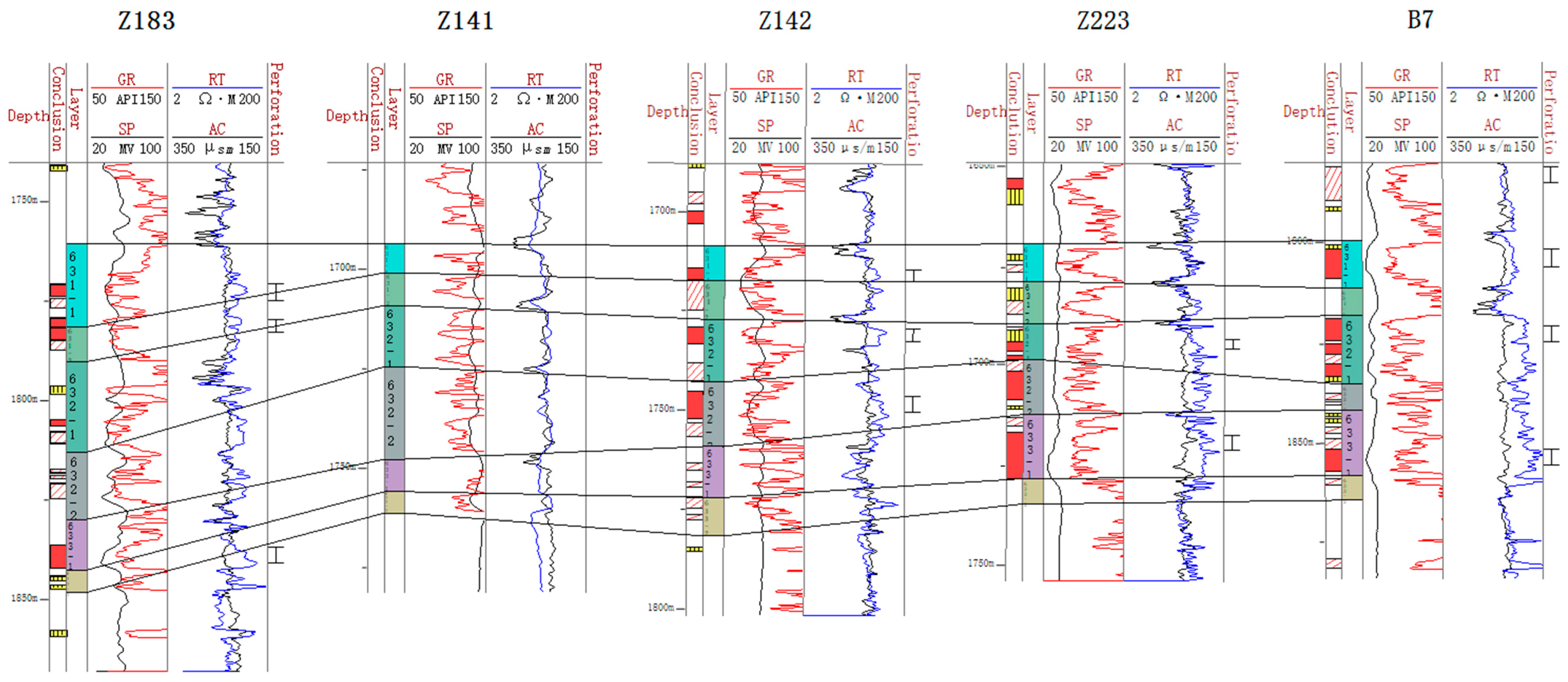
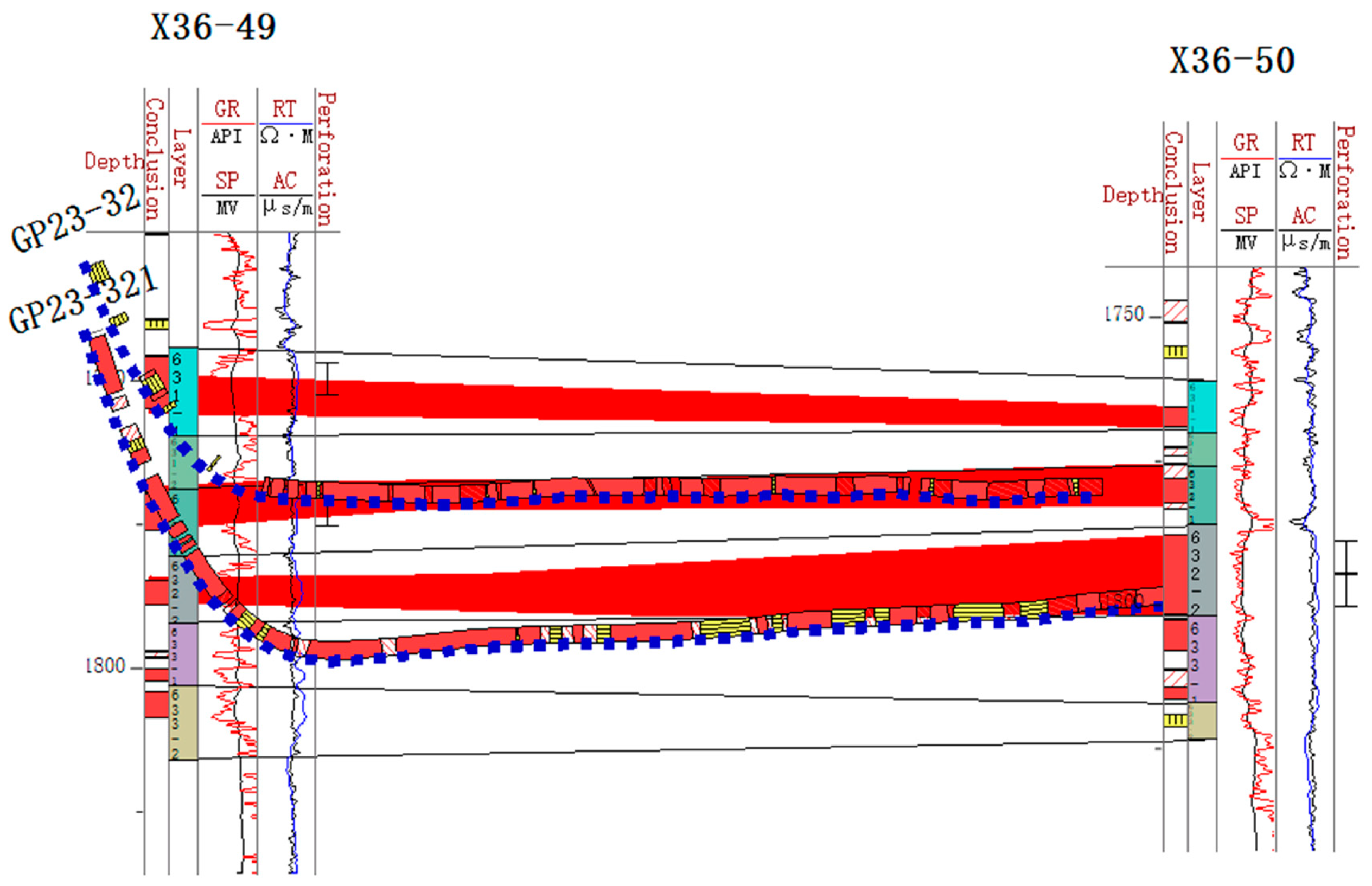
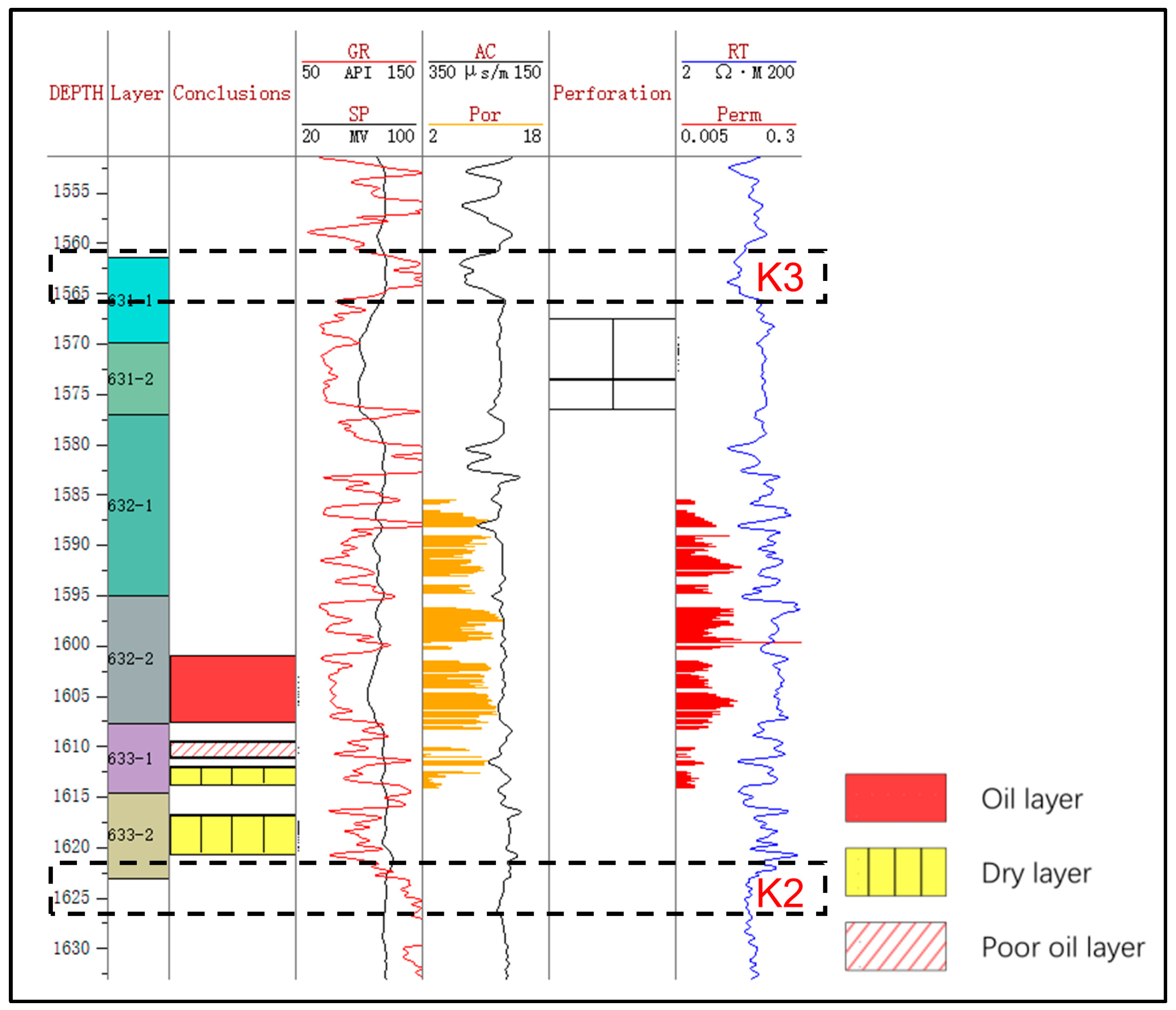



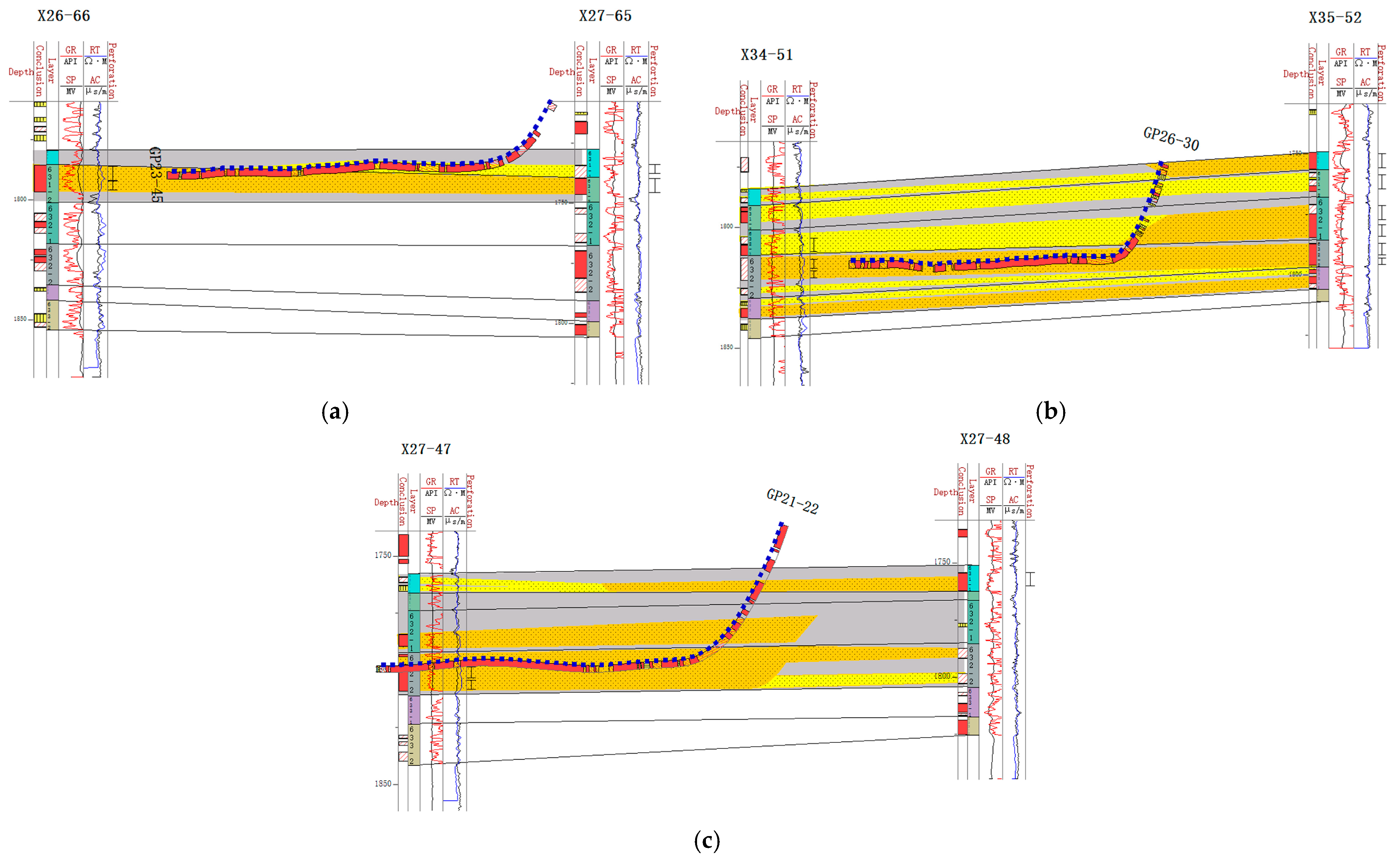
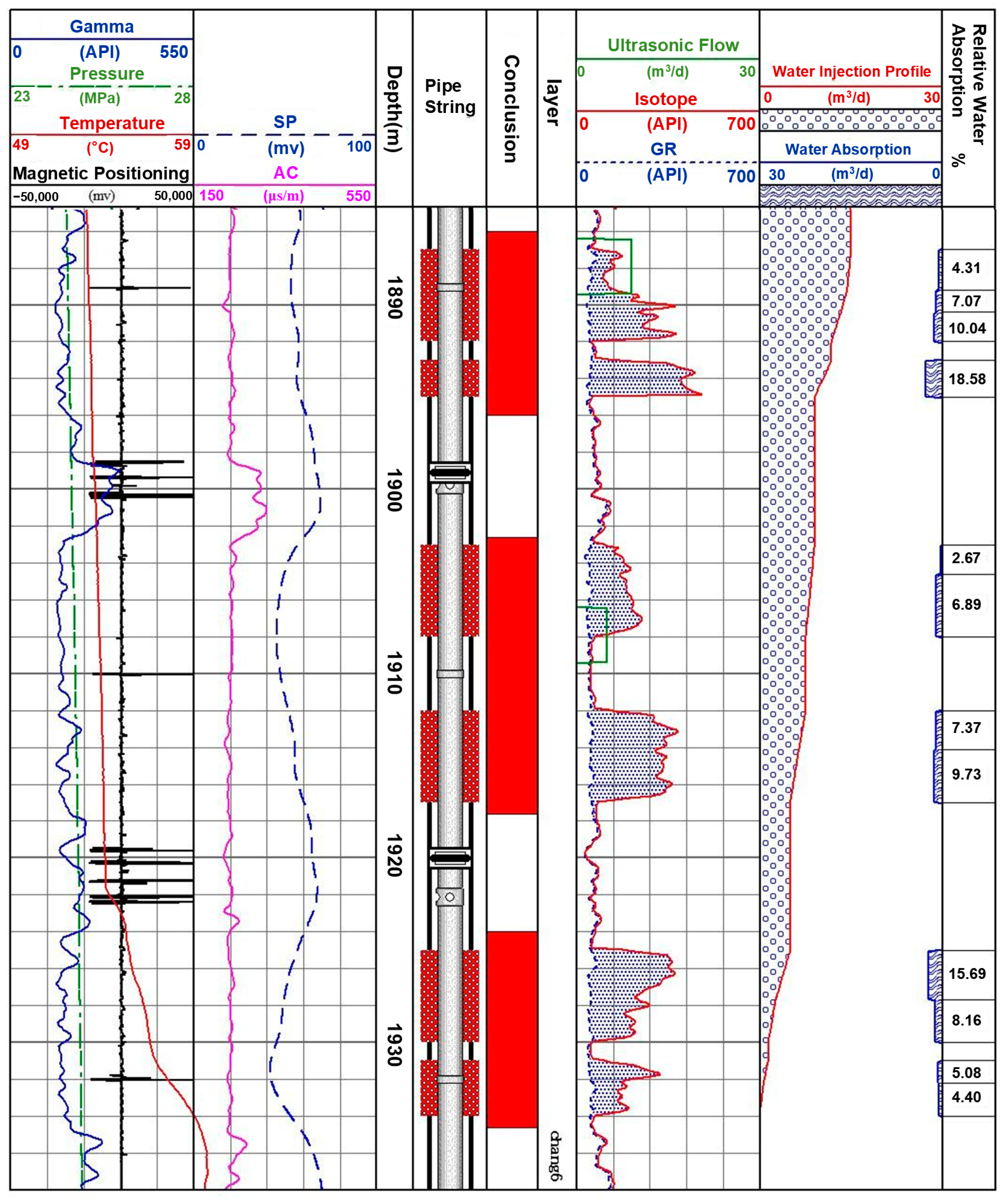

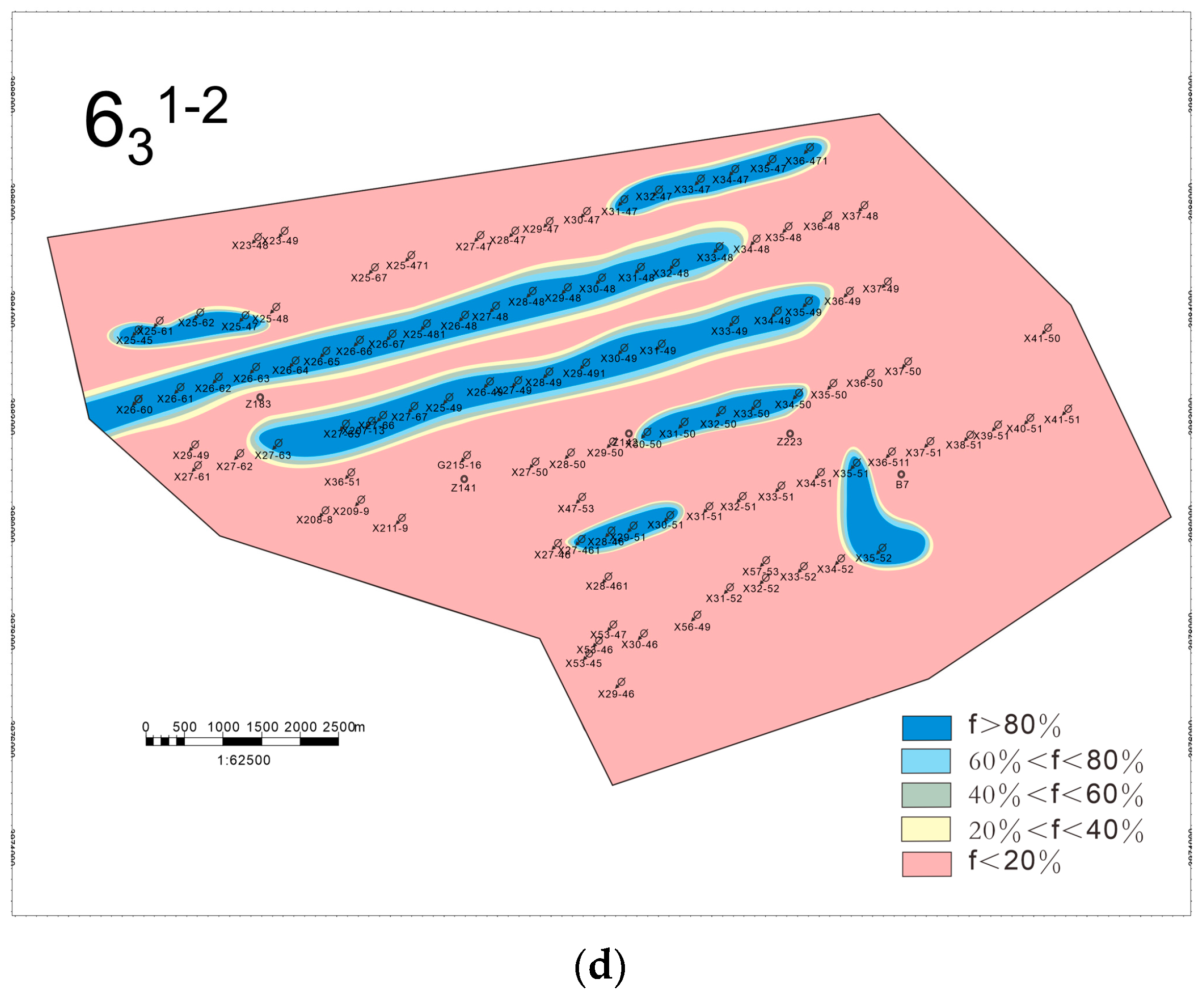

| Depth (m) | Density (g/cm3) | Porosity (%) | Permeability (mD) | Oil Saturation (%) | Water Saturation (%) |
|---|---|---|---|---|---|
| 1707.52 | 2.43 | 9.25 | 0.21 | 20.64 | 30.77 |
| 1714.72 | 2.41 | 10.3 | 0.10 | 35.86 | 18.98 |
| 1722.09 | 2.41 | 10.73 | 0.13 | 6.6 | 53.59 |
| 1733.47 | 2.38 | 10.47 | 0.12 | 9.62 | 56.81 |
| 1741.32 | 2.38 | 10.96 | 0.14 | 7.7 | 48.5 |
| 1744.45 | 2.4 | 9.75 | 0.09 | 11.04 | 45.35 |
| 1760.51 | 2.38 | 9.74 | 0.10 | 8.6 | 48.19 |
| Facies | Lithology | Characteristic | Logging Identification | GR | Development | Reservoir Type |
|---|---|---|---|---|---|---|
| Main body of debris flow deposit | Gray fine sandstone | Blocky, rare mudstone debris, visible calcareous cementation interlayer | GR: Box shaped and bell shaped SP: Negative anomalies |  | Frequently | I |
| Edge of debris flow deposit | Gray fine sandstone | Blocky, high shale content, thickness less than the main body, frequent calcareous interlayers | GR: Serrated bell shaped SP: Negative anomalies |  | Frequently | II |
| Turbidity current deposits | Thin layer of gray fine sandstone | Frequent interbedding of fine sandstone and mudstone sand layer thickness < 0.5 m | Layer thickness limited SP negative anomalies not obvious |  | Less | III |
| Semi-deep and deep lacustrine mudstone | (Gray) Black mudstone, silty mudstone, pelitic siltstone | Horizontal bedding development | High GR value SP baseline |  | Medium | Non |
| Sand Body Width (m) | Number | Frequency (%) | Interlayer Width (m) | Number | Frequency (%) |
|---|---|---|---|---|---|
| <20 | 1687 | 66.68 | <10 | 407 | 61.02 |
| 20–60 | 631 | 24.94 | 10–20 | 156 | 23.39 |
| 60–100 | 119 | 4.70 | 20–30 | 48 | 7.20 |
| 100–140 | 48 | 1.90 | 30–40 | 28 | 4.20 |
| 140–180 | 20 | 0.79 | 40–50 | 19 | 2.85 |
| 180–220 | 11 | 0.43 | >50 | 9 | 1.35 |
| >220 | 14 | 0.55 |
| Type | Contact | Sand Body Stacking | Profile | Plane | Connectivity | Development Layer |
|---|---|---|---|---|---|---|
| Overlapping | Overlapping contact | 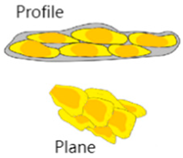 |  |  | Connected | Chang-631632 Main development |
 |  | |||||
 |  | |||||
 |  | Disconnected | ||||
| Splicing | Splicing contact | 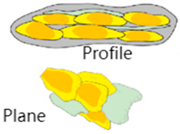 |  |  | Weakly connected | Chang-631632 Secondary development |
 |  | |||||
| Isolation | Non-contact | 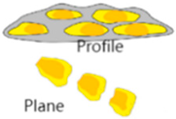 |  |  | Disconnected | Chang-633 Secondary development |
 |  | |||||
 | ||||||
| Well | Monitoring Technology | Tracer Types |
|---|---|---|
| X26-49 | Trace substance tracer | Ce |
| X27-46 | Chemical tracer | Bromide ion |
| X33-52 | Element tracer | Sodium nitrite |
| X32-50 | Element tracer | Er |
| Corresponding Oil Well | Well Distance (m) | Tracer Breakthrough Time (D) | Rate of Water Cut (%) | Volume Affected (m3) | Conductivity (mD·mm) | Conclusion |
|---|---|---|---|---|---|---|
| GP161–102 | 375 | 26 | 16.5 | 6 | 28.5 | High-permeability belt |
| GP22–22 | 248 | 6 | 74.5 | 456 | 54.5 | High-permeability belt |
| GP22–211 | 327 | 37 | 37.4 | 19 | 7.4 | High-permeability belt |
| GP22–22 | 248 | 8 | 74.5 | 109 | 44 | High-permeability belt |
| GP22–21 | 290 | 12 | 25.2 | 37 | 64.9 | High-permeability belt |
| GP22–21 | 290 | 17 | 25.2 | 14 | 30.3 | High-permeability belt |
Disclaimer/Publisher’s Note: The statements, opinions and data contained in all publications are solely those of the individual author(s) and contributor(s) and not of MDPI and/or the editor(s). MDPI and/or the editor(s) disclaim responsibility for any injury to people or property resulting from any ideas, methods, instructions or products referred to in the content. |
© 2025 by the authors. Licensee MDPI, Basel, Switzerland. This article is an open access article distributed under the terms and conditions of the Creative Commons Attribution (CC BY) license (https://creativecommons.org/licenses/by/4.0/).
Share and Cite
An, X.; Li, Y.; Yang, H.; Wan, W.; Hui, G.; Li, H.; Zhang, C.; Lu, X.; Pi, Z.; Ge, C.; et al. Study on the Depositional Microfacies and Internal Architecture of Sandy Debris Flows in Low-Permeability Oilfields: Implications for Remaining Oil Recovery in the HeShui Oilfield. Processes 2025, 13, 1016. https://doi.org/10.3390/pr13041016
An X, Li Y, Yang H, Wan W, Hui G, Li H, Zhang C, Lu X, Pi Z, Ge C, et al. Study on the Depositional Microfacies and Internal Architecture of Sandy Debris Flows in Low-Permeability Oilfields: Implications for Remaining Oil Recovery in the HeShui Oilfield. Processes. 2025; 13(4):1016. https://doi.org/10.3390/pr13041016
Chicago/Turabian StyleAn, Xiaoping, Ye Li, Huanying Yang, Wenchun Wan, Gang Hui, Hongchang Li, Chunhui Zhang, Xuejiao Lu, Zhiyang Pi, Chenqi Ge, and et al. 2025. "Study on the Depositional Microfacies and Internal Architecture of Sandy Debris Flows in Low-Permeability Oilfields: Implications for Remaining Oil Recovery in the HeShui Oilfield" Processes 13, no. 4: 1016. https://doi.org/10.3390/pr13041016
APA StyleAn, X., Li, Y., Yang, H., Wan, W., Hui, G., Li, H., Zhang, C., Lu, X., Pi, Z., Ge, C., Yao, F., Bao, P., Zhang, Y., Yang, X., & Zhang, Y. (2025). Study on the Depositional Microfacies and Internal Architecture of Sandy Debris Flows in Low-Permeability Oilfields: Implications for Remaining Oil Recovery in the HeShui Oilfield. Processes, 13(4), 1016. https://doi.org/10.3390/pr13041016








